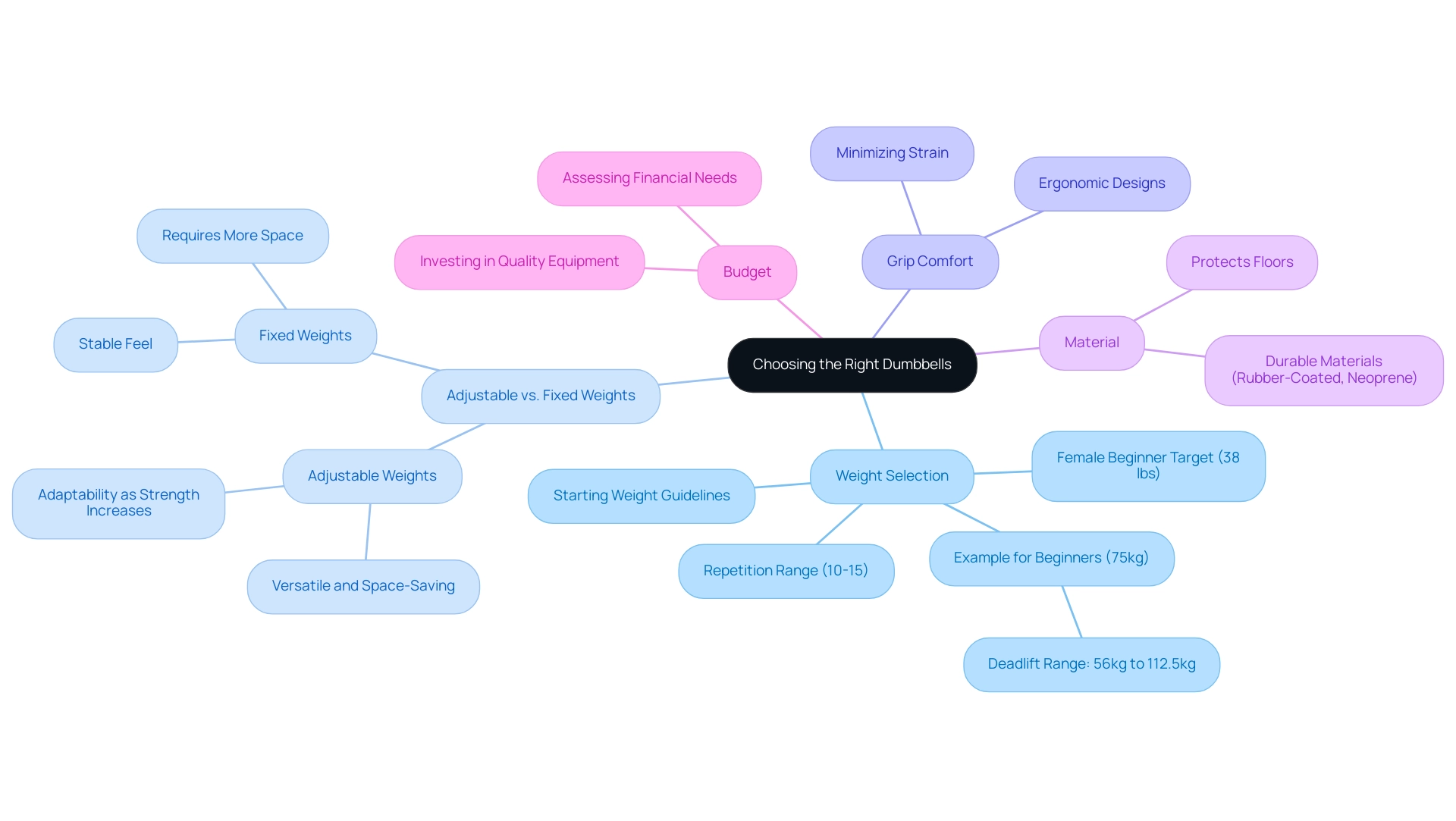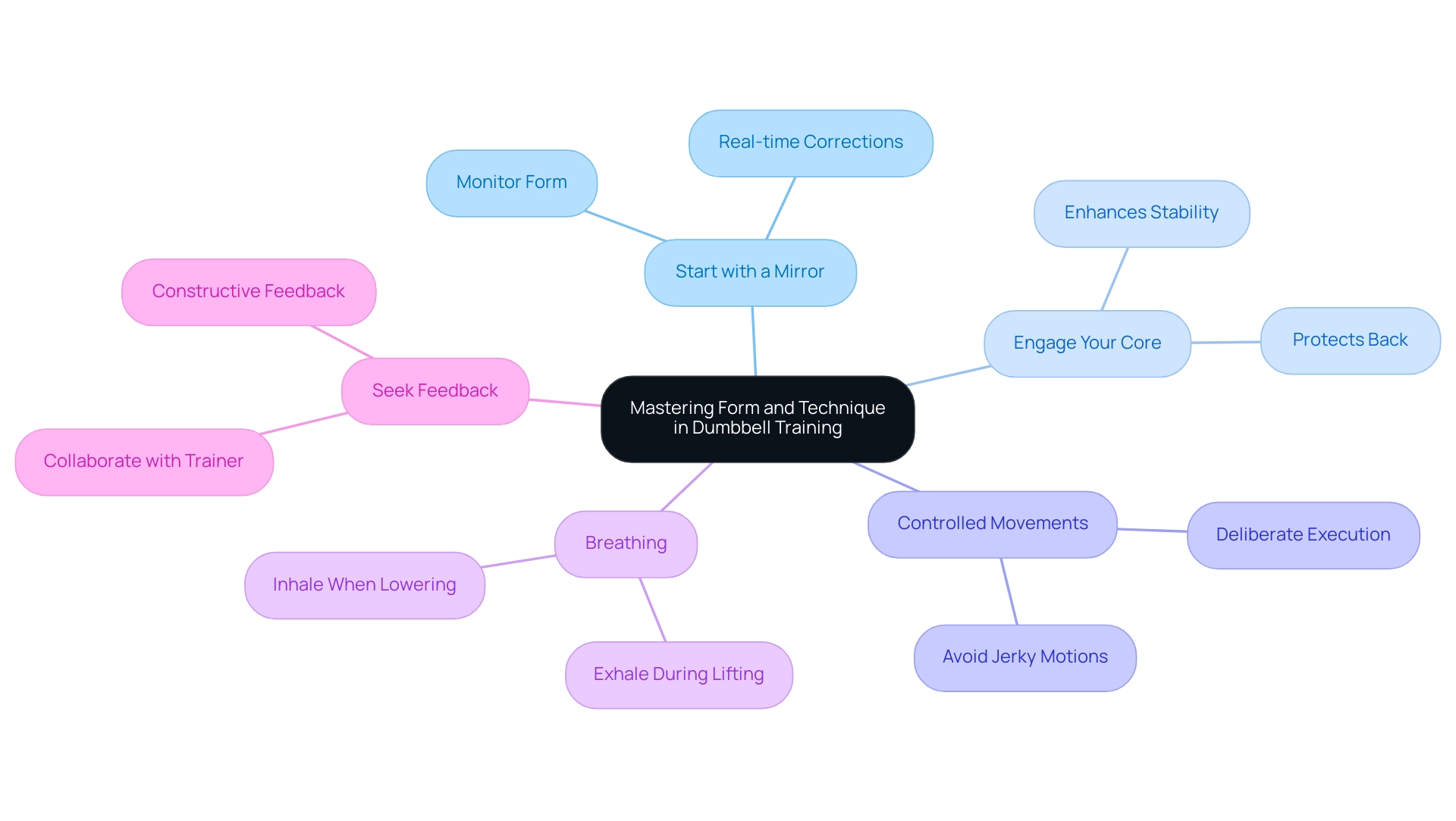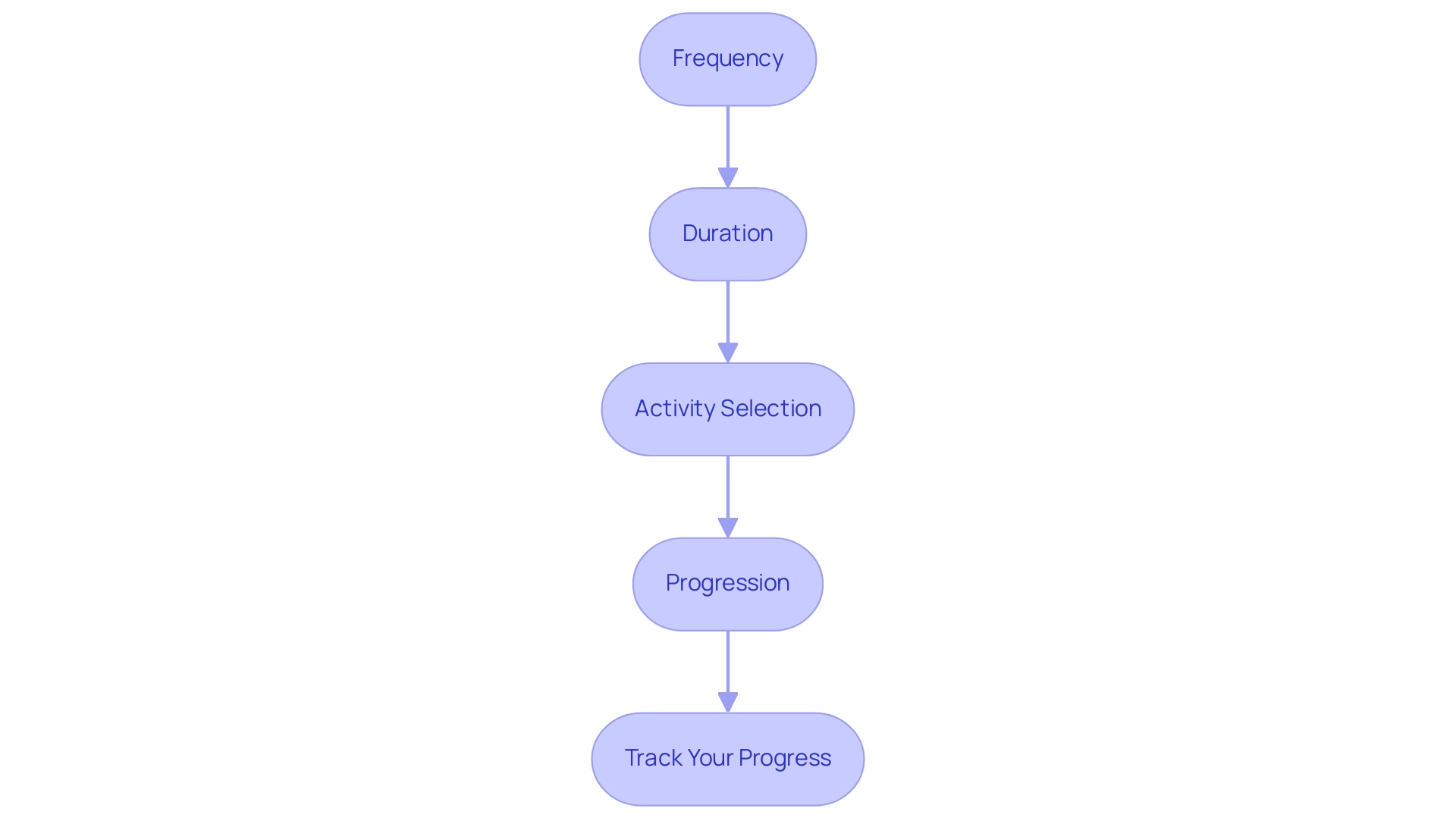Overview
To start beginner dumbbell workouts effectively, individuals should focus on setting realistic goals, warming up properly, and mastering form and technique while gradually increasing weights. The article emphasizes that these foundational practices not only enhance safety and performance but also foster confidence and long-term success in strength training.
Introduction
Embarking on a fitness journey can be an exhilarating yet daunting experience, especially for those new to strength training. Dumbbell workouts offer an accessible and versatile way to build strength, enhance overall fitness, and boost confidence. With the right guidance and a positive mindset, beginners can navigate the world of dumbbell exercises with ease.
This article is designed to equip newcomers with essential tips, effective exercises, and practical advice for selecting the right equipment, ensuring that each step taken is towards a healthier, stronger self.
By embracing these foundational principles, individuals will not only cultivate a rewarding workout routine but also unlock their potential for long-term success in their fitness endeavors.
Getting Started with Dumbbell Workouts: Essential Tips for Beginners
Embarking on your beginner dumbbell workouts journey begins with fostering a positive mindset. Here are some empowering tips to set you on the right path:
- Set Realistic Goals: Start by establishing achievable objectives. Focus on completing a set number of workouts each week or mastering fundamental movements. This approach not only builds confidence but also paves the way for long-term success.
- Warm-Up: A proper warm-up is crucial. Engaging in dynamic stretches or light cardio prepares your muscles, enhances performance, and significantly reduces the risk of injury. Recent studies highlight the advantages of warm-up routines, demonstrating that they can result in enhanced performance and decreased soreness after workouts.
- Start Slow: Prioritize learning the movements and developing confidence before increasing weights. Gradual progression is essential; as your power enhances, so should the challenge of your workouts. For instance, the total 6RM loads for barbell bench press (BBP) were noted at 88.5 ± 16.0kg, in contrast to 40.5 ± 7.7kg for flyes (DF), emphasizing the effectiveness of barbell exercises for strength development.
- Listen to Your Body: Be attuned to how your body responds during your workouts. Distinguish between discomfort and pain—if you feel pain, pause and reassess your technique or the weight you are using. This mindfulness ensures long-term sustainability in your fitness journey. As Vidar Andersen, Associate Professor at Western Norway University, states, "If the primary aim of the exercise is maximal mechanical stress (i.e., loading) and muscle activity of the prime movers, the authors recommend the use of barbell bench press and not flyes."
- Stay Hydrated: Hydration is vital for optimal performance. Ensure you drink water before, during, and after workouts to support your body’s functions and recovery.
By adopting these essential tips, you’ll establish a secure and pleasant atmosphere for your beginner dumbbell workouts. Furthermore, a case study on training modalities for inexperienced lifters suggests that machines may be more advantageous for beginners due to their lower stability requirements, reinforcing the importance of choosing suitable activities. This approach sets you up for a successful and fulfilling fitness experience.

Top Dumbbell Exercises for Beginners: A Step-by-Step Guide
Here are some top weightlifting routines designed specifically for beginners to help build a strong foundation:
-
Dumbbell Squats:
- Stand with your feet shoulder-width apart, gripping a dumbbell in each hand at your sides. This exercise not only strengthens your legs but also enhances your balance and stability.
- Lower your body by bending your knees, keeping your chest lifted and back straight. This proper form is crucial for avoiding injury.
- Push through your heels to return to a standing position, ensuring you engage your core throughout the movement.
-
Dumbbell Bench Press:
- Lie back on a bench or the floor, with a dumbbell in each hand, arms extended straight above your chest. This exercise targets the pectorals, shoulders, and triceps, contributing to an overall upper body workout.
- Slowly lower the dumbbells to your shoulders, with control, before pressing them back up to the starting position. Remember, as Assal Arian, a fitness instructor, advises, > Just make sure to recover after each session < to allow your muscles to rebuild and grow stronger.
-
Dumbbell Rows:
- Bend forward at the hips while holding a dumbbell in each hand, allowing your arms to hang down. This movement effectively engages the lats and upper back, promoting better posture.
- Pull the dumbbells towards your waist, squeezing your shoulder blades together, then lower them back down with care.
-
Dumbbell Deadlifts:
- Stand with your feet hip-width apart, holding dumbbells in front of your thighs. This exercise is vital for developing strength in your posterior chain, including your glutes and hamstrings.
- Hinge at the hips and lower the dumbbells towards the ground, ensuring your back remains straight throughout the motion.
- Return to standing by pushing through your heels, reinforcing proper lifting mechanics.
-
Incline Single Arm Back Row:
- Start in front of a bench with one forearm braced on it and a dumbbell on the ground. This modification offers a great way to target the lats, upper back, and core effectively.
- Pull the dumbbell towards your hip, focusing on maintaining a stable core and proper form.
-
Triceps Kickback:
- In this exercise, beginners stand with a dumbbell in each hand and hinge at the hips while keeping a flat back. The movement involves extending the arms backward to engage the triceps.
- This exercise primarily targets the triceps while ensuring proper form to avoid overextending the elbow joint.
These exercises not only target key muscle groups, promoting overall fitness, but they also serve as a stepping stone for beginners looking to enhance their strength training journey. Significantly, resistance exercise has been demonstrated to enhance bone mineral density (BMD) in the spine by 5.34%, which is especially advantageous for individuals with osteoarthritis, as it can alleviate joint discomfort and enhance mobility. As trends continue to evolve in 2024, incorporating these effective weight exercises will help build confidence and mastery in your workout routine.

Choosing the Right Dumbbells: A Guide for New Lifters
Choosing the appropriate weights is essential for developing an effective regimen for beginner dumbbell workouts. Here are key considerations to keep in mind:
-
Weight Selection: Start with lighter weights to concentrate on mastering your form and technique.
A solid guideline is to choose a weight that enables you to complete 10-15 repetitions with proper form, while still feeling challenging by the last few reps. For instance, a beginner weighing 75kg (165lbs) might aim for a deadlift range of 56kg (123lbs) to 112.5kg (248lbs), ensuring a balanced approach to development. Additionally, female beginners should aim to lift around 38 lbs (1RM), which is considered impressive compared to the general population.
-
Adjustable vs. Fixed Weights: The choice between adjustable and fixed weights can significantly impact your training experience.
Adjustable weights are incredibly versatile and space-saving, allowing you to modify resistance as you progress in strength. On the other hand, fixed weights are straightforward and often provide a more stable feel, though they may require more space.
According to recent reviews, many fitness experts advocate for adjustable weights due to their adaptability and cost-effectiveness in the long run.
-
Grip Comfort: Comfort during workouts is paramount. Ensure that the weights you choose have a comfortable grip that suits your hand size.
Ergonomic designs can minimize strain, enhancing your workout experience and enabling longer training sessions.
-
Material: Choose weights crafted from durable materials, such as rubber-coated or neoprene.
These options not only offer a better grip but also help protect your floors from damage during your workouts.
-
Budget: Assess your budget carefully. It's important to find weights that meet your needs without straining your finances.
Investing in quality equipment can lead to improved results in your fitness journey.
By carefully choosing the appropriate weights, you establish the foundation for a successful and enjoyable workout experience with beginner dumbbell workouts that prioritizes your well-being and fitness objectives. Furthermore, comprehending power standards classification can assist in establishing practical expectations and objectives for your conditioning journey.

Mastering Form and Technique: Key to Safe Dumbbell Training
To excel in your strength training journey, mastering form and technique during beginner dumbbell workouts is paramount. Here are essential guidelines to help you achieve that:
-
Start with a Mirror: Utilize a mirror to monitor your form throughout your workouts.
This immediate visual feedback is invaluable for making real-time corrections, ensuring you maintain proper alignment and posture.
-
Engage Your Core: Prioritize engaging your core muscles with every repetition.
This not only enhances stability but also protects your back, reducing the risk of injury and allowing for more effective lifting.
-
Controlled Movements: Focus on performing each exercise with deliberate, controlled movements.
Avoid any jerky or rapid motions that could compromise your form and lead to injuries. Remember, precision trumps speed.
-
Breathing: Synchronize your breathing with your movements.
Exhale during the exertion phase—when lifting the weight—and inhale as you lower it. This technique aids in maintaining a steady rhythm and supports your overall performance.
-
Seek Feedback: If possible, collaborate with a trainer or an experienced workout partner who can provide constructive feedback on your form and technique.
This external perspective can be crucial in identifying areas for improvement in beginner dumbbell workouts.
By diligently focusing on these aspects of form and technique during beginner dumbbell workouts, you not only maximize their effectiveness but also significantly reduce the risk of injury. This foundational work establishes the groundwork for ongoing advancement and achievement in your physical development pursuits.
The advantages are evident: research shows that resistance exercises can improve mental health, resulting in heightened self-esteem and a favorable body image, which are essential for overall wellness. Additionally, one study found that strength exercises may increase lean muscle mass, and another highlighted that bone mass density in the spine increased by 5.34% after strength exercises. These outcomes emphasize the significance of mastering form and technique in your practice.

Building Your Beginner Dumbbell Workout Plan: Structure and Consistency
To create an effective beginner dumbbell workout plan, consider the following structured approach:
- Frequency: Aim for a minimum of 2-3 strength workouts each week. This frequency allows your body adequate rest between sessions, which is crucial for recovery and muscle growth. Notably, recent analyses indicate that no significant differences were found between exercising 3 and 6 days per week after 6 weeks, emphasizing the importance of a balanced routine rather than excessive frequency.
- Duration: Start with sessions lasting 20-30 minutes. This manageable timeframe is ideal for beginner dumbbell workouts and can be gradually increased as your stamina improves. Consistency is crucial; as highlighted by expert Godsey, 'Consistency is vital, but if you don't observe changes after approximately eight weeks, you are not training intensively enough and need to vary your routine by increasing your weight or sets or the number of activities.' Thus, monitor your progress and adjust as needed.
- Activity Selection: Choose 4-6 activities that engage different muscle groups. This balanced approach ensures comprehensive strength development and reduces the risk of overuse injuries.
- Progression: Once you feel comfortable with the activities, it's vital to introduce gradual increases in weight or repetitions. This progression challenges your muscles, fostering growth and enhancing performance.
- Track Your Progress: Keep a workout journal to record your activities, weights, and repetitions. Tracking progress not only keeps you accountable but also serves as a motivational tool as you witness your improvements over time.
Additionally, a case study highlights the importance of accurate reporting in strength training research, where the exclusion of a non-volume-matched study was corrected, ensuring the integrity of the findings. Despite this, the overall conclusions regarding the positive effect of higher frequencies on upper body pressing exercises remain unchanged.
By diligently structuring your beginner dumbbell workouts and committing to consistency, you lay a solid foundation for success in your fitness journey, ultimately paving the way for lasting health and performance enhancements.

Conclusion
Embarking on a journey with dumbbell workouts is a powerful step toward achieving personal fitness goals. By setting realistic objectives, prioritizing proper warm-ups, and listening to the body's signals, beginners can foster a safe and effective training environment. The importance of mastering fundamental exercises cannot be overstated, as they lay the groundwork for building strength and confidence.
Choosing the right equipment, from weight selection to grip comfort, is crucial in ensuring a positive workout experience. As individuals progress, understanding the significance of form and technique will help mitigate the risk of injury while maximizing the effectiveness of each movement. Structured workout plans that emphasize frequency, duration, and progression will guide newcomers in establishing a consistent routine that promotes long-term success.
Ultimately, the journey into strength training is not just about physical transformation; it’s about cultivating resilience, confidence, and a commitment to personal well-being. By embracing these foundational principles, beginners can unlock their potential and pave the way for a healthier, stronger future. The time to take action is now—commit to the process, and watch as the benefits unfold both in and out of the gym.
Frequently Asked Questions
What mindset should beginners have when starting dumbbell workouts?
Beginners should foster a positive mindset by setting realistic goals, focusing on achievable objectives, and building confidence through completing a set number of workouts each week or mastering fundamental movements.
Why is warming up important before workouts?
Warming up is crucial as it prepares the muscles, enhances performance, and significantly reduces the risk of injury. Engaging in dynamic stretches or light cardio before workouts has been shown to improve performance and decrease soreness.
How should beginners approach increasing weights during workouts?
Beginners should start slow by learning the movements and developing confidence before increasing weights. Gradual progression is essential; as strength improves, the challenge of the workouts should also increase.
What should beginners do if they feel pain during workouts?
Beginners should listen to their bodies and distinguish between discomfort and pain. If they experience pain, they should pause to reassess their technique or the weight being used to ensure long-term sustainability in their fitness journey.
How important is hydration during workouts?
Hydration is vital for optimal performance. Beginners should ensure they drink water before, during, and after workouts to support their body’s functions and recovery.
What are some beginner dumbbell exercises to start with?
Some beginner dumbbell exercises include: Dumbbell Squats, Dumbbell Bench Press, Dumbbell Rows, Dumbbell Deadlifts, Incline Single Arm Back Row, and Triceps Kickback.
What are the benefits of resistance exercise for beginners?
Resistance exercise helps target key muscle groups, promotes overall fitness, and has been shown to enhance bone mineral density, which is particularly beneficial for individuals with osteoarthritis, as it can alleviate joint discomfort and enhance mobility.

